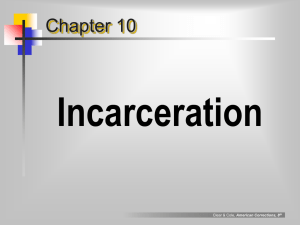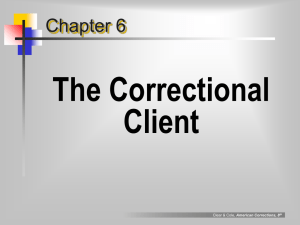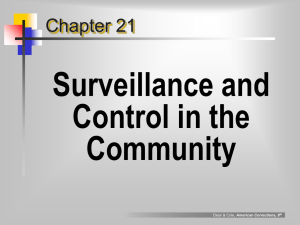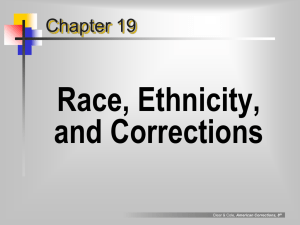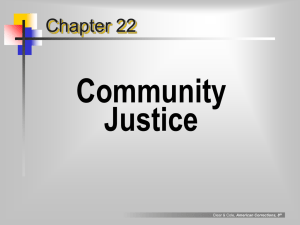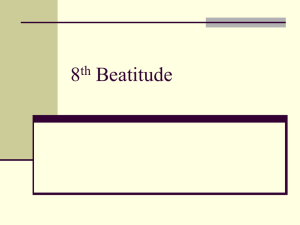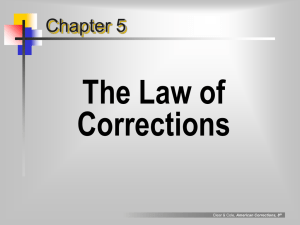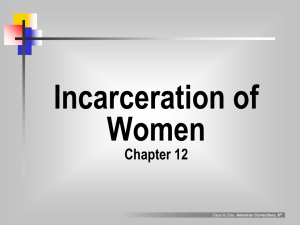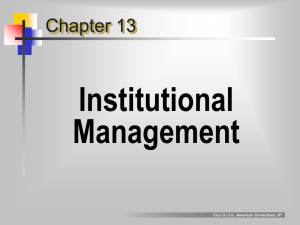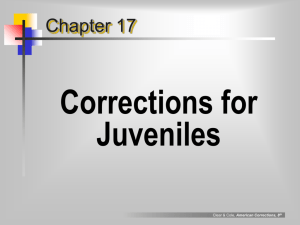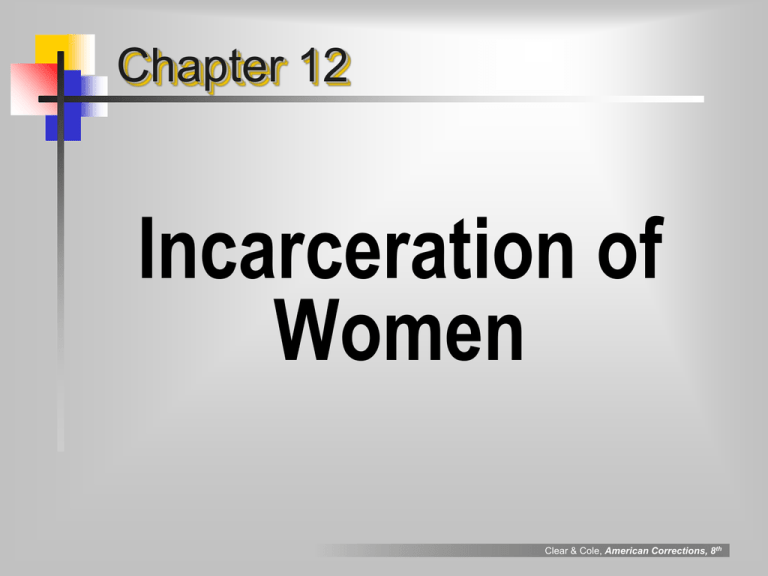
Chapter 12
Incarceration of
Women
Clear & Cole, American Corrections, 8th
Incarceration of Women
Women: Forgotten Offenders
Historical Perspective
The Incarceration of Women in the United States
The Reformatory Movement
The Post-World War II Years
Women in Prison
Characteristics of Women in Prison
The Subculture of Women’s Prison
Males versus Female Subcultures
Issues in the Incarceration on Women
Sexual Misconduct
Educational and Vocational Programs
Medical Services
Mothers and Their Children
Release to the Community
Clear & Cole, American Corrections, 8th
Why women tend to be
the “forgotten offenders”
women commit fewer crimes than men
female criminality tends to be less serious
than male criminality
historically, women have tended more
often than men to be “excluded” from the
justice system, by lenient treatment
women constitute a small proportion of the
correctional population (6%)
popular social attitude tends to put all
females in a subservient position
Clear & Cole, American Corrections, 8th
Imprisonment of Women in The US
Clear & Cole, American Corrections, 8th
Institutionalized “Sexism”:
caused by low status of female criminality
women’s
prisons are located farther from
friends & family, inhibiting visits,
especially for the poor
women’s prisons lack diverse educational,
vocational, and other programs available
in men’s prisons
women’s prisons lack specialization in
treatment and fail to segregate offenders
who present special problems or have
special needs
Clear & Cole, American Corrections, 8th
gender and crime:
who’s arrested for what?
Clear & Cole, American Corrections, 8th
evolution of women’s prisons
1st female-run
prison for women
Indiana, 1873
run for women, by
women
House of Shelter
Detroit, post civil war
1st reformatory for
women.
run by Zebulon
Brockway
Alderson Prison
West Virginia, 1927
1st federal prison
for women.
Mary Belle Harris,
warden
Women’s Prison
Asso.
New York, 1844
created to improve
treatment of &
separate females from
male inmates
END of
reformatory
movement
“ran its course” by
1935; no new
correctional
models
Elizabeth Fry
1780 - 1845
1st to press for
reform in
treatment of
women &
children
Clear & Cole, American Corrections, 8th
female prison reform in 1800s guiding
principles
separation of women from men
provision of differential care for
women
management of women’s prisons
by female staff
Clear & Cole, American Corrections, 8th
features distinguishing female from
male prisons
smaller
women’s
prisons
looser
security
inmate-staff
relations less
structured
shorter
sentences
less committed to
inmate code
less physical
violence
less developed
underground
economy
Clear & Cole, American Corrections, 8th
female inmate profiles
predominately
Black (46%)
or White (36%)
between ages of 25 - 34 (50%)
never married (45%)
some high school (46%)
or graduated (23%)
Similar to characteristics of
male inmates
Clear & Cole, American Corrections, 8th
female prison subcultures
(per Heffernan)
“square” (like ‘gleaning’)
situational offender
adheres to conventional
“the
life” (like ‘jailing’)
norms & values
persistent offenders
act in prison as they did on the outside
antisocial, stand firm against authority
represent about half of female prisoners
“cool” (like ‘doing time’)
professionals;
controlled & manipulative;
‘keep busy, play around, stay out of
trouble and get out’
Clear & Cole, American Corrections, 8th
“pseudo-families”
a distinguishing hallmark of the
“subculture” in many women’s prisons
(as compared with men’s)
women
often cope with the stresses of
incarceration by bonding together in
extended “families” of convenience.
different women play the roles of various
members of the family, including father,
mother, siblings, grandchildren, even
cousins
Clear & Cole, American Corrections, 8th
key issues in the incarceration of
women
educational
& vocational training
female programs tend to reflect stereotypical
“female” occupations
women’s programs less ambitious than men’s
medical
services
women have more serious health problems
mothers
& their children
167,000 American children (2/3 of whom are
under 10) have a mother in jail or prison
65% of incarcerated mothers were single
caretakers of minor children.
Clear & Cole, American Corrections, 8th
official sexual misconduct
in prison
number
of cases of misconduct by male
officers in on increase, with increase in
female inmates
e.g., Houston Cagle & Susan Smith, 2000
Officers
may abuse authority to compel
sex by withholding goods and privileges to
prisoners or by rewarding them with same
42 states have enacted legislation
prohibiting sexual misconduct
Clear & Cole, American Corrections, 8th

